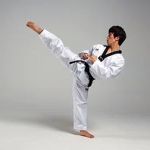 How to Execute a Sliding Front Kick for Closing Distancesliding front kick, closing distance, martial arts kicks, front kick technique, sliding kick, taekwondo kick, how to close distance in combat, martial arts footworkLearn how to execute a sliding front kick for closing distance in martial arts. This guide explains the technique, key steps, and tips to help you master this powerful kick and improve your combat skills.
How to Execute a Sliding Front Kick for Closing Distancesliding front kick, closing distance, martial arts kicks, front kick technique, sliding kick, taekwondo kick, how to close distance in combat, martial arts footworkLearn how to execute a sliding front kick for closing distance in martial arts. This guide explains the technique, key steps, and tips to help you master this powerful kick and improve your combat skills.- Understanding the Sliding Front Kick
- When to Use a Sliding Front Kick for Closing Distance
- How to Execute the Sliding Front Kick
- Common Mistakes to Avoid
- Why Choose Jeuns TKD Hub for Martial Arts Training
Understanding the Sliding Front Kick
The sliding front kick is a technique commonly used in various martial arts disciplines, including taekwondo, karate, and kickboxing. It’s a dynamic move that involves closing the distance between you and your opponent while delivering a powerful front kick. Unlike a standard front kick, which is executed by stepping in or maintaining distance, the sliding front kick allows you to quickly close the gap and apply pressure in close-range combat.
This kick is especially useful when you need to advance towards your opponent and deliver a strike in one fluid motion. It combines speed, power, and precision, making it an effective tool for both offensive and defensive strategies in martial arts sparring or self-defense situations.

Kim's Hapkido Martial Arts / kim's hapkido
PasadenaLos Angeles CountyCalifornia
3324 E Colorado Blvd, Pasadena, CA 91107, USA
When to Use a Sliding Front Kick for Closing Distance
Knowing when to use the sliding front kick is crucial to its effectiveness. It’s most useful in situations where you need to close the distance between you and your opponent quickly while staying aggressive. Here are a few scenarios where this technique excels:
1. When the Opponent is Out of Reach
One of the main reasons to use a sliding front kick is when your opponent is too far away to land a regular kick or punch. By sliding in, you can cover the distance, creating the opportunity for a clean, direct strike. This makes the sliding front kick ideal for long-range opponents who are attempting to maintain distance.
2. To Disrupt Your Opponent's Rhythm
The sliding front kick can also be used as a way to disrupt an opponent’s rhythm, especially if they are trying to advance towards you. It’s an excellent technique to throw off their timing, as the sudden approach can catch them off guard, preventing them from making the first move.
3. In Close-Quarters Combat
When the fight is at close range, the sliding front kick can help you quickly close the gap and deliver a powerful strike. This makes it ideal for situations where you need to press your attack without giving your opponent a chance to recover or counterattack.
How to Execute the Sliding Front Kick
Executing a sliding front kick involves a few key steps to ensure you’re delivering it with speed, power, and accuracy. Here’s how to break it down:
1. Start with a Solid Stance
Begin in a fighting stance with your feet shoulder-width apart. Your knees should be slightly bent, and your weight evenly distributed. You’ll need to be in a position where you can move quickly without losing balance. A strong, balanced stance is essential for executing the sliding motion smoothly.
2. Slide Your Back Foot
The key difference between a regular front kick and the sliding front kick is the sliding motion. To perform this technique, you’ll start by sliding your back foot forward, bringing it closer to your front foot. This creates the momentum needed to propel your body forward, closing the distance between you and your opponent.
It’s important to keep the slide smooth and controlled, not too rushed. The foot should slide directly along the floor to avoid lifting it too high, which could lose valuable time and create an opening for counterattacks.
3. Kick with Precision
As your back foot slides forward, immediately follow up with a front kick using your lead leg. The front kick should be executed with precision and power, aiming for vulnerable areas such as the opponent’s stomach, chest, or head. The idea is to use the momentum from your sliding foot to drive the kick with force, maintaining control throughout the motion.
4. Recover and Reset
Once the kick has landed (or missed), quickly return to your fighting stance. Be prepared for your opponent’s response and ready to continue the engagement. Keep your guard up and your posture strong to avoid being caught off-guard by counterattacks.
Common Mistakes to Avoid
While the sliding front kick is an effective technique, there are common mistakes that can make it less effective. Here are a few things to avoid:
1. Rushing the Slide
A common mistake is rushing the sliding motion. If you don’t slide smoothly, you might lose balance or leave yourself vulnerable to a counterattack. Focus on controlling the motion to ensure you’re in a strong position when executing the kick.
2. Lifting the Back Foot Too High
Another mistake is lifting the back foot too high during the slide. This can slow you down and make you an easy target. Keep the back foot close to the ground to maintain momentum and control.
3. Not Engaging the Core
The sliding front kick requires a lot of core strength to maintain stability and control. Not engaging the core can result in a weaker kick and poor balance. Make sure to tighten your core during the entire movement to ensure maximum efficiency.
Why Choose Jeuns TKD Hub for Martial Arts Training
If you’re looking to improve your martial arts skills and learn techniques like the sliding front kick, look no further than Jeuns TKD Hub. Our expert instructors are dedicated to helping you master the fundamentals of taekwondo and other martial arts. Whether you're a beginner or an experienced practitioner, we offer a variety of classes tailored to your needs and skill level.
Visit Jeuns TKD Hub today to explore our classes, training programs, and learn more about how we can help you take your martial arts skills to the next level. Master techniques like the sliding front kick and become a more effective, confident fighter!








 Rocky Mountain Martial Arts- Aspen Moo Duk Kwan0.0 (0 reviews)
Rocky Mountain Martial Arts- Aspen Moo Duk Kwan0.0 (0 reviews) M.Y. Taekwondo & After School.4.0 (46 reviews)
M.Y. Taekwondo & After School.4.0 (46 reviews) IMA Nihon Karate Do USA5.0 (25 reviews)
IMA Nihon Karate Do USA5.0 (25 reviews) Greenwich Kempo5.0 (40 reviews)
Greenwich Kempo5.0 (40 reviews) Union UTA Martial Arts / SAMI Combat Systems Of NJ4.0 (308 reviews)
Union UTA Martial Arts / SAMI Combat Systems Of NJ4.0 (308 reviews) Kajukenbo0.0 (0 reviews)
Kajukenbo0.0 (0 reviews) How to Execute a Jumping Roundhouse Kick to the Head
How to Execute a Jumping Roundhouse Kick to the Head How to Execute a Double Kick Combination in Sparring
How to Execute a Double Kick Combination in Sparring How to Perform a Flawless Axe Kick: A Step-by-Step Guide
How to Perform a Flawless Axe Kick: A Step-by-Step Guide DIY Tae Kwon Do Training Equipment for Home Practice
DIY Tae Kwon Do Training Equipment for Home Practice How to Increase Your Vertical Jump for Tae Kwon Do Flying Kicks
How to Increase Your Vertical Jump for Tae Kwon Do Flying Kicks The History of the Tae Kwon Do Peace Corps
The History of the Tae Kwon Do Peace Corps